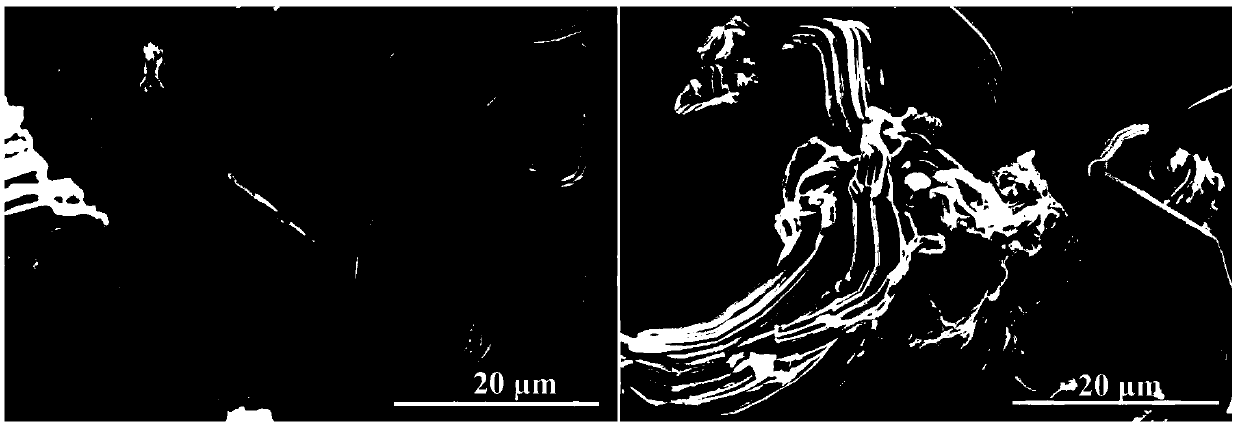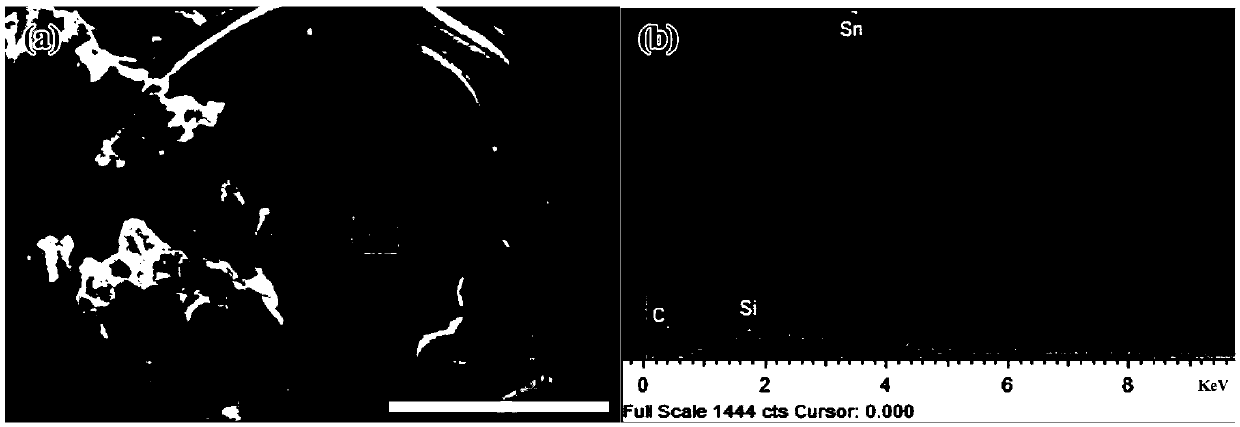Si-Sn composite material used for Li-ion battery anode and preparation method thereof
A lithium ion battery and composite material technology, which is applied in the field of silicon-containing fiber winding and wrapping lithium ion battery composite material and its preparation field, can solve the problems of difficult industrialized production, low production efficiency and high preparation cost, and achieves simple operation and high production cost. The effect of low and high specific capacity
- Summary
- Abstract
- Description
- Claims
- Application Information
AI Technical Summary
Problems solved by technology
Method used
Image
Examples
Embodiment 1
[0032] Si prepared by high energy ball milling 50 sn 50 Filament winding and wrapping composite materials, and used as lithium-ion battery anode materials for electrochemical performance testing.
[0033] 1. For the nominal composition Si 50 sn 50 In terms of atomic percentage, the atomic percentage of silicon element is 50 at.%, and the atomic percentage of tin element is 50 at.%, which meet the composition range required in the technical scheme.
[0034] 2. Mix the selected raw material silicon powder and tin powder according to the proportion (silicon: 50 at.%, tin: 50 at. %) and put them into the ball milling tank supporting the ball milling equipment. In this embodiment, high-energy ball mills use bearing steel balls with diameters of 10 mm, 8 mm and 5 mm, and the mass ratio of balls to mixed powder is 16:1. The ball milling was carried out under an argon protective atmosphere, and the ball milling speed was 250 rpm. Si obtained after 20 h high energy ball milling 5...
Embodiment 2
[0044] Fiber-wrapped Si 20 sn 80 Composite materials, and used as lithium-ion battery anode materials for electrochemical performance testing. The difference from Example 1 is that different ratios are used in the composition ratio. The preparation method and testing process are the same as in Example 1.
[0045] The resulting silicon-containing fiber-wrapped Si prepared in this example 20 sn 80 Composite material, wherein the content of silicon element is 20at.%, the content of tin element is 80at.%, its XRD pattern is as follows Figure 8 As shown, silicon and tin exist in the form of single substances. In the silicon-containing composite material, the fiber structure content is relatively small, and the particle size is about 20-30 μm. The test results of charge-discharge cycle performance are as follows: Figure 9 As shown, the first discharge capacity is 1050mAh / g, and the capacity remains at 350mAh / g after 20 cycles.
Embodiment 3
[0047] Fiber-wrapped Si 30 sn 70 Composite materials, and used as lithium-ion battery anode materials for electrochemical performance testing. The difference from Example 1 is that different ratios are used in the composition ratio. The preparation method and testing process are the same as in Example 1.
[0048] The resulting silicon-containing fiber-wrapped Si prepared in this example 30 sn 70 Composite material, wherein the content of silicon element is 30at.%, the content of tin element is 70at.%, its XRD pattern is as follows Figure 8 As shown, silicon and tin exist in the form of single substances. In the silicon-containing composite material, the fiber structure content is relatively small, and the particle size is about 20-30 μm. The test results of charge-discharge cycle performance are as follows: Figure 9 As shown, the first discharge capacity is 1300mAh / g, and the capacity remains at 600mAh / g after 20 cycles.
PUM
| Property | Measurement | Unit |
|---|---|---|
| Particle size | aaaaa | aaaaa |
| Size | aaaaa | aaaaa |
Abstract
Description
Claims
Application Information
 Login to View More
Login to View More - Generate Ideas
- Intellectual Property
- Life Sciences
- Materials
- Tech Scout
- Unparalleled Data Quality
- Higher Quality Content
- 60% Fewer Hallucinations
Browse by: Latest US Patents, China's latest patents, Technical Efficacy Thesaurus, Application Domain, Technology Topic, Popular Technical Reports.
© 2025 PatSnap. All rights reserved.Legal|Privacy policy|Modern Slavery Act Transparency Statement|Sitemap|About US| Contact US: help@patsnap.com



